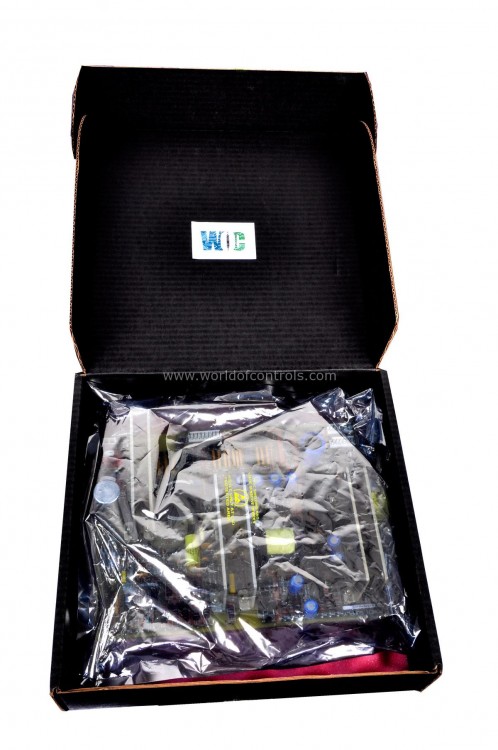SPECIFICATIONS
Part Number: DS200TCCAF1BDD
Manufacturer: General Electric
Series: Mark V
Product type: Software EPROM
Availability: In Stock
Country of Manufacture: United States (USA)
Functional Description
DS200TCCAF1BDD is a Software EPROM designed and developed by GE. It is a part of the Mark V control system. The Erasable Programmable Read-Only Memory stands as a critical component in various systems, notably employed by security system manufacturers in access control panels. Renowned for its ability to retain data even when there's no power supply, EPROMs serve a pivotal role by storing both the operating system and program instructions essential for access control operations.
Features
- In access control systems, the Central Processing Unit (CPU) executes logical functions pivotal for system operations. However, it derives its instructions from the EPROM, which holds the programming and operational guidelines for the control panel.
- A significant delineation between fourth and fifth-generation access control systems lies in the role of the EPROM in determining system functionalities. Fourth-generation systems exclusively rely on EPROMs for all their instructions, limiting their capabilities to perform only the functions predefined within the EPROM's programming.
- In contrast, fifth-generation access control systems exhibit a more advanced operational paradigm. While they still acquire instructions from EPROMs, they also draw a substantial portion of their instructions from Structured Query Language (SQL) databases or similar repositories in other languages. This integration allows for a more dynamic and expansive range of functionalities.
- The crucial distinction emerges in the system's capability: fourth-generation systems strictly adhere to the instructions preprogrammed in the EPROM, restricting their operational scope. On the other hand, fifth-generation systems harness the flexibility of SQL databases, along with the status of inputs and outputs, counters, and timers, enabling them to perform a vast array of functions. This expanded capability means that virtually any function imaginable within the scope of access control can be executed by a fifth-generation system.
- In essence, while fourth-generation access control systems rely solely on EPROM programming for their functionalities, fifth-generation systems leverage the dynamic capabilities of SQL databases alongside EPROM instructions, empowering them to perform a diverse and comprehensive range of operations tailored to the evolving needs of access control and security.
System Log functions
- Log functions within a system like the Mark V serve critical roles in capturing, recording, and analyzing various events, alarms, and operational data. Here's an expanded explanation of the log functions provided:
- Alarm Logging: Alarms are logged as they occur and clear with a high resolution of 62 milliseconds. This log records alarm occurrences and their resolution, ensuring a comprehensive history of system alerts.
- Turbine Parameter Logging: The system can log up to 63 turbine parameters. This feature allows for the continuous monitoring and recording of crucial turbine data, enabling performance analysis and diagnostics.
- Events Logging (Turbine Operation): Significant turbine events, such as engaging the turning gear or closing the generator breaker, are logged with individual time tags at a resolution of 62 milliseconds. These events are customizable by users and can be edited in the field, providing detailed insights into operational activities.
- Events Logging (Contact Inputs): Contact inputs registered by the system are logged on the printer with individual time tags at a remarkably precise resolution of 1 millisecond. All contact inputs to the Mark V system are included in this event log. Users have the flexibility to activate or deactivate logging and selectively delete specific contact inputs from the log.
- Trip Log: The trip log is a critical record capturing up to 60 alarms that occurred at the time of the turbine trip. This log is crucial for turbine trip analysis and fault diagnosis. Each sample within the trip log can encompass up to 63 parameters, consisting of 38 pre-trip samples spanning 5 hours and 3 post-trip samples covering 3 seconds. This data is accessible on the display or can be printed for detailed analysis. Notably, the log clears and starts overwriting memory locations once the unit restarts, releasing the freeze on the trip log.
- These log functions collectively form a robust system for recording and storing diverse data types, including alarms, operational events, turbine parameters, and trip-related information. They are instrumental in providing operators and maintenance personnel with a detailed history of system performance, aiding in troubleshooting, analysis, and optimization of the turbine's operation.
WOC is available 24x7 to assist you with any of your General Electric requirements. Please contact us by phone or email for pricing and availability on GE, Bently Nevada or Woodward parts and repairs.
FREQUENTLY ASKED QUESTIONS
What is DS200TCCAF1BDD?
It is a Software EPROM designed and developed by GE
Can users customize event logging related to turbine operations?
Yes, significant turbine events, such as engaging the turning gear or closing the generator breaker, are logged with individual time tags at a 62-millisecond resolution. These events are customizable and editable in the field, providing detailed insights into operational activities.
How are contact inputs handled and logged by the system?
Contact inputs registered by the Mark V system are meticulously logged on the printer with individual time tags at a precise resolution of 1 millisecond. All contact inputs are included, and users can manage logging, enabling selective deletion of specific inputs from the log.
What is the purpose of the Trip Log, and what information does it capture?
The Trip Log captures up to 60 alarms that occurred during a turbine trip, offering critical data for trip analysis and fault diagnosis. Each sample within this log contains up to 63 parameters, comprising 38 pre-trip samples spanning 5 hours and 3 post-trip samples spanning 3 seconds. This information can be accessed on the display or printed for detailed analysis.
How do these log functions benefit operators and maintenance personnel?
These comprehensive log functions provide a detailed history of system performance, aiding operators and maintenance personnel in troubleshooting, analysis, and optimizing turbine operation for enhanced efficiency and reliability.
